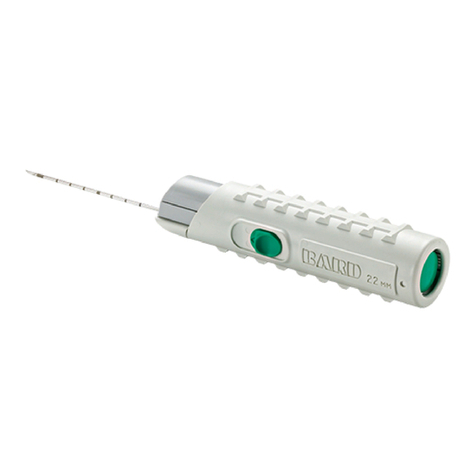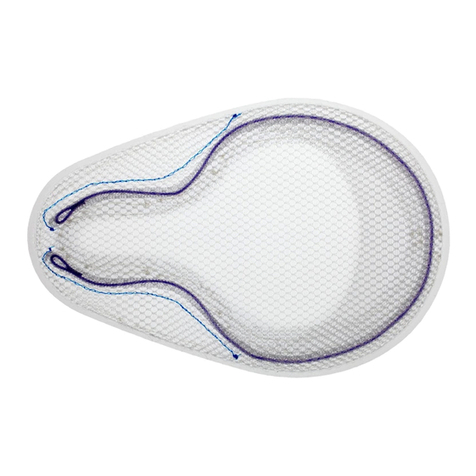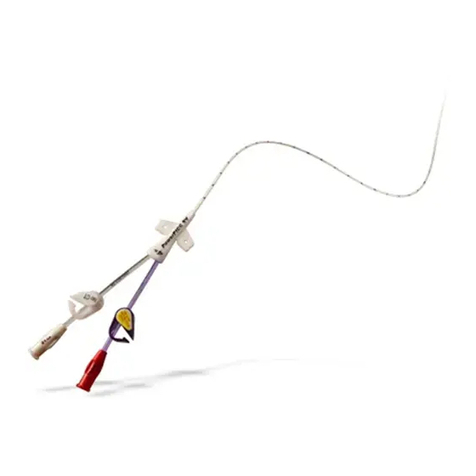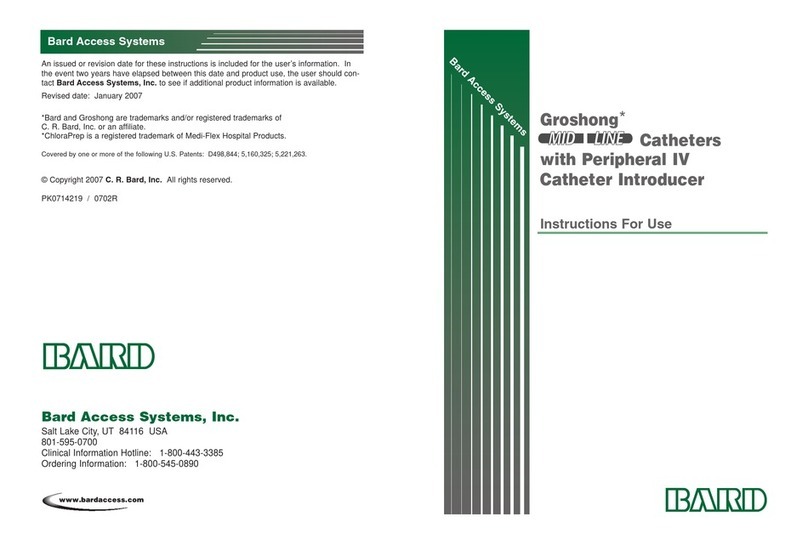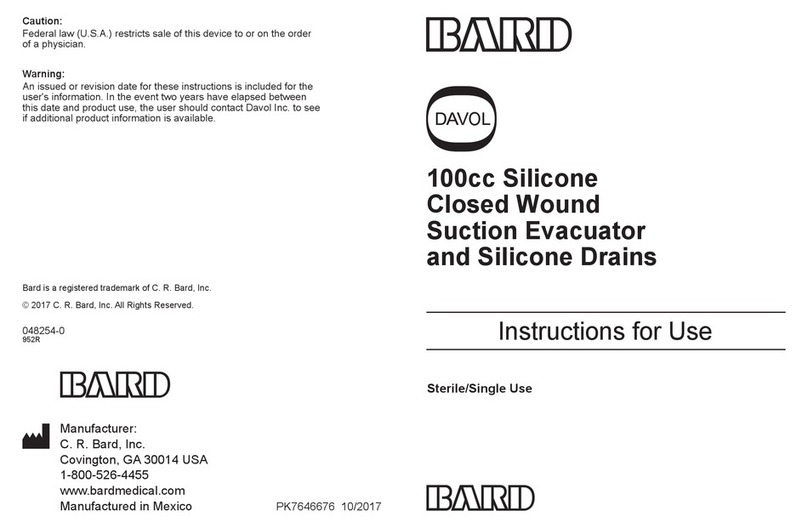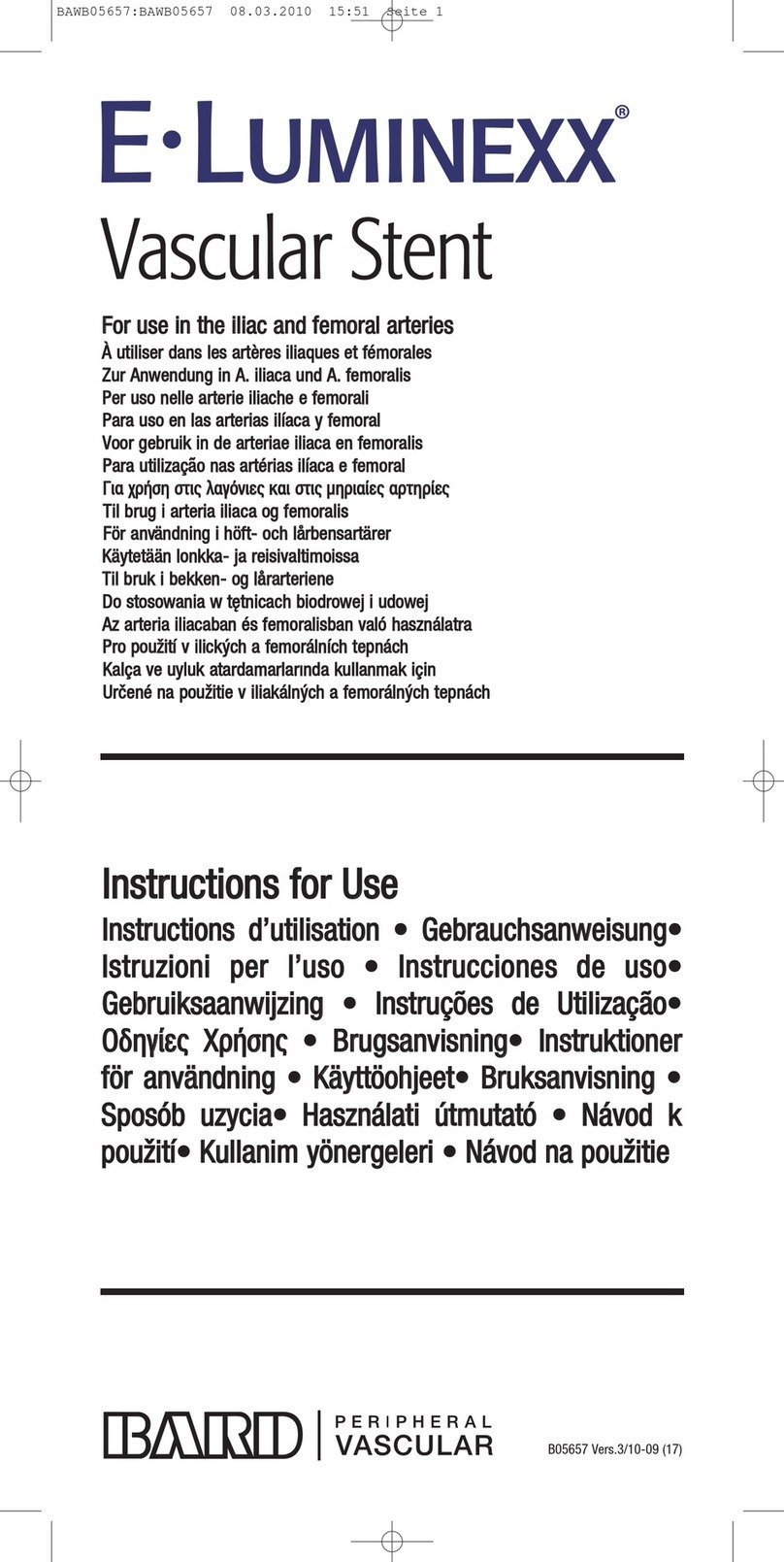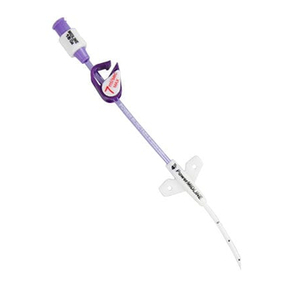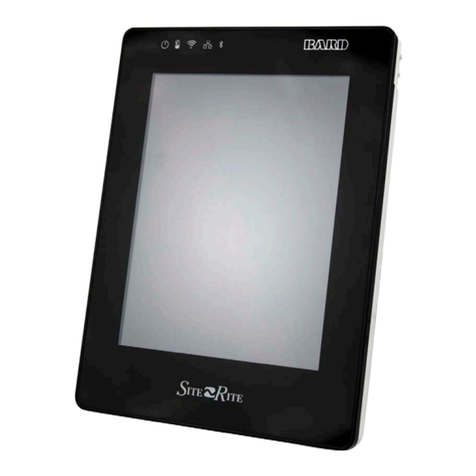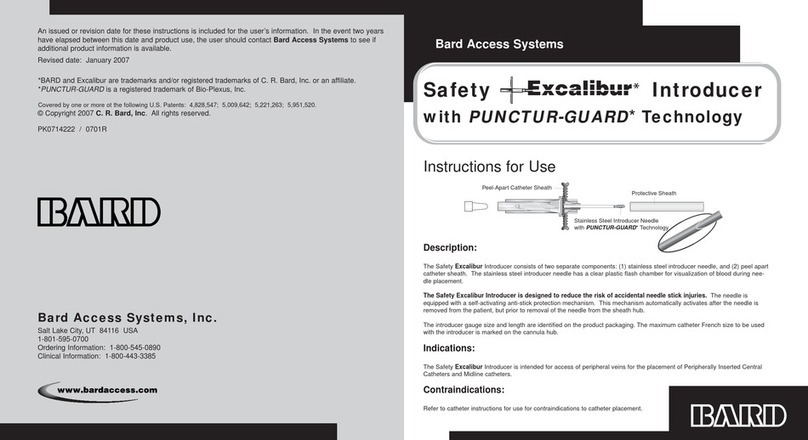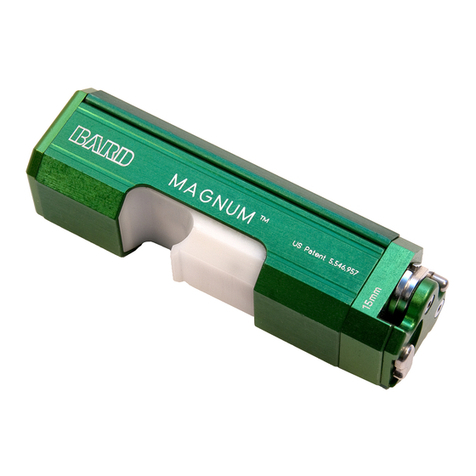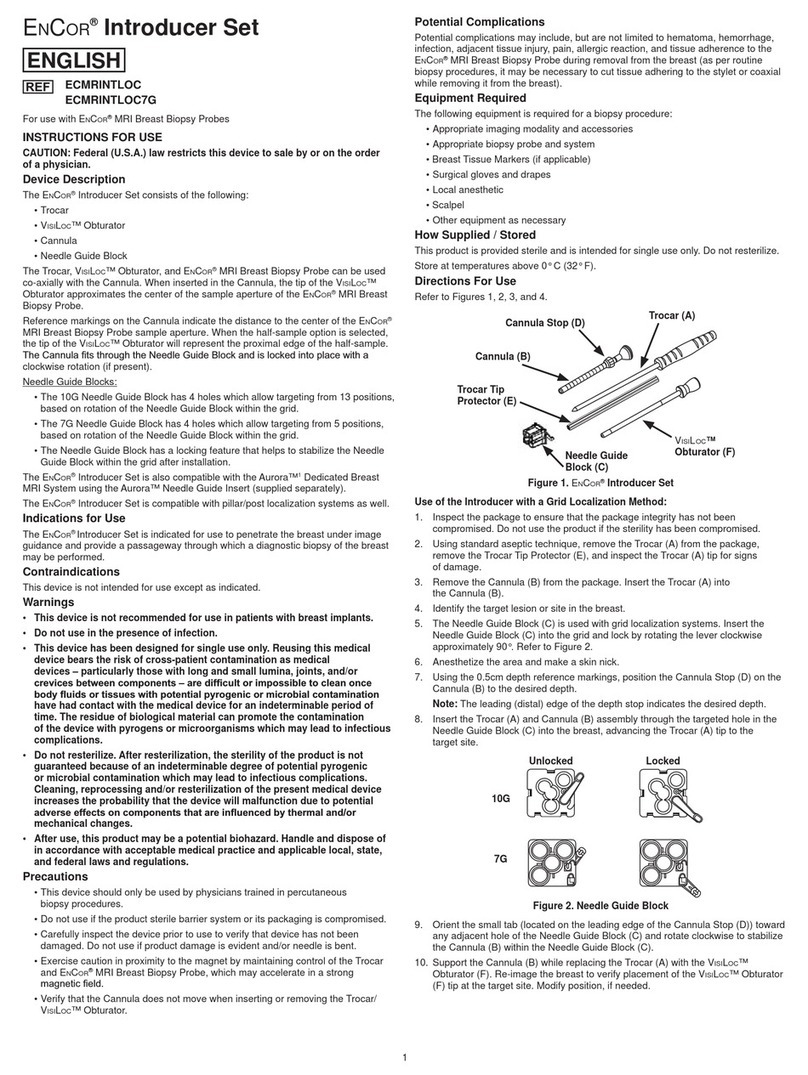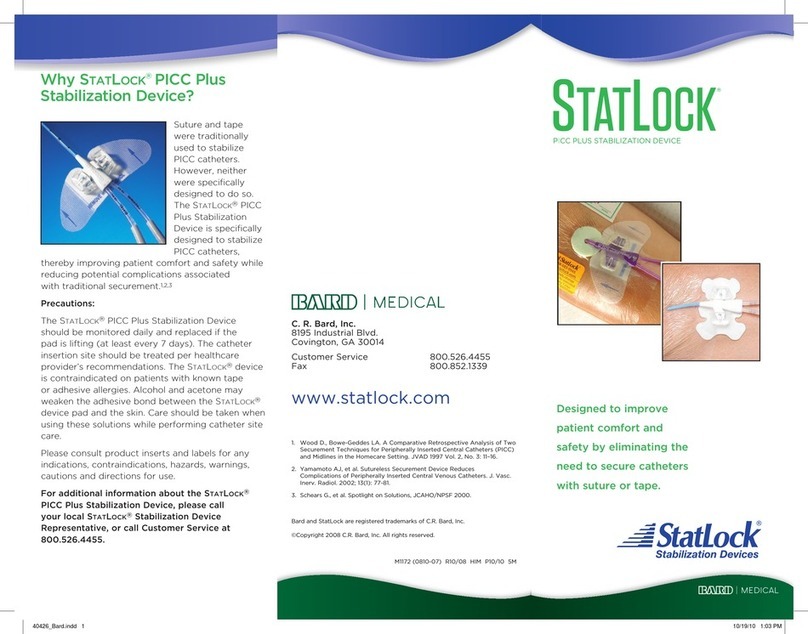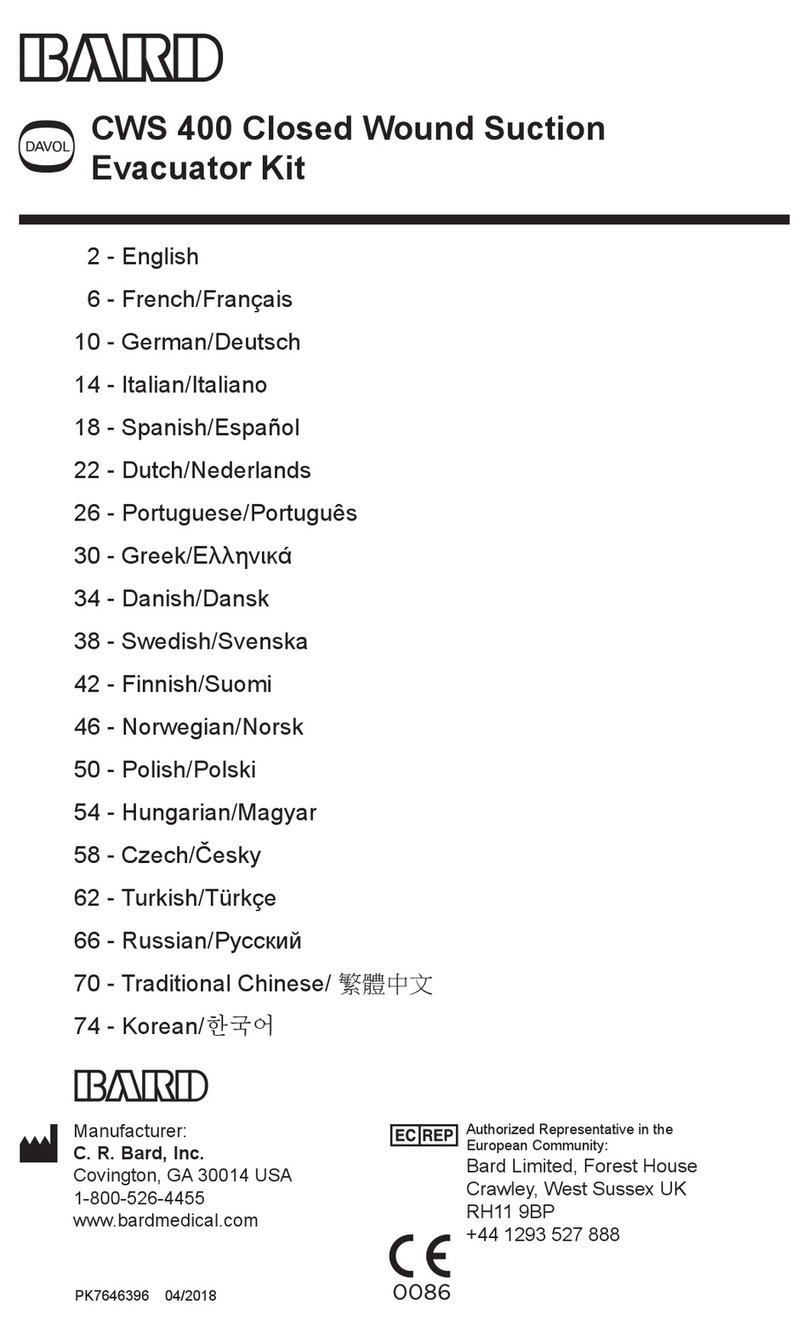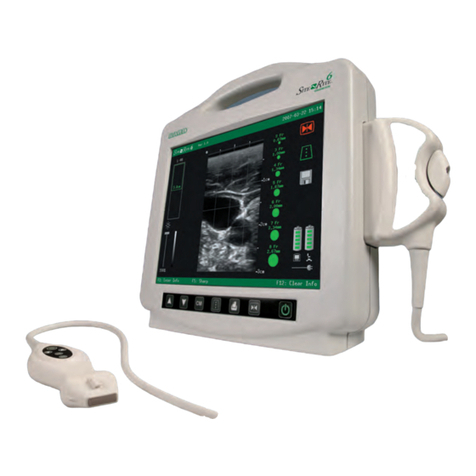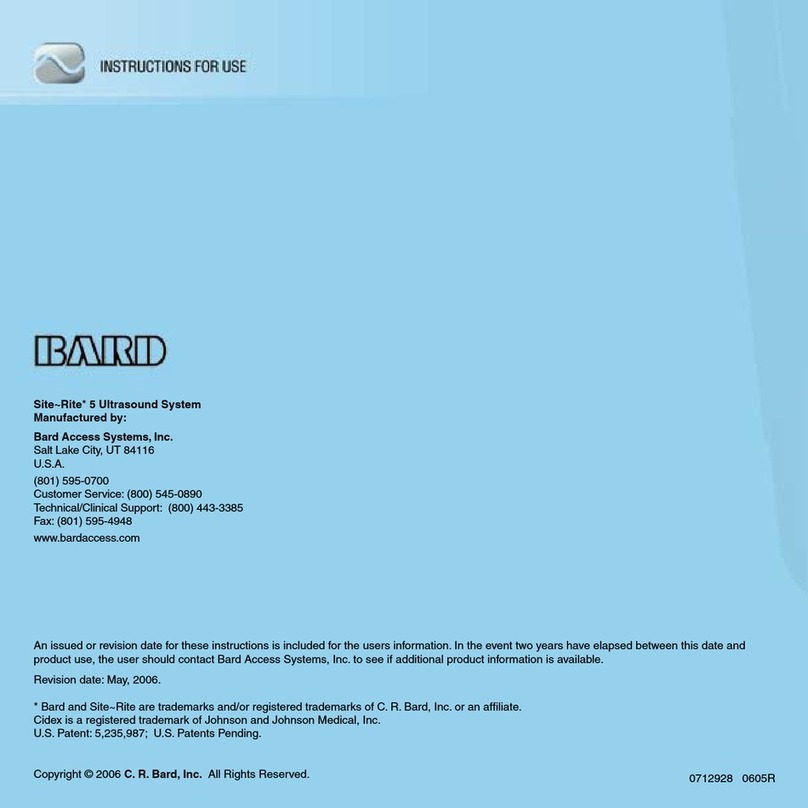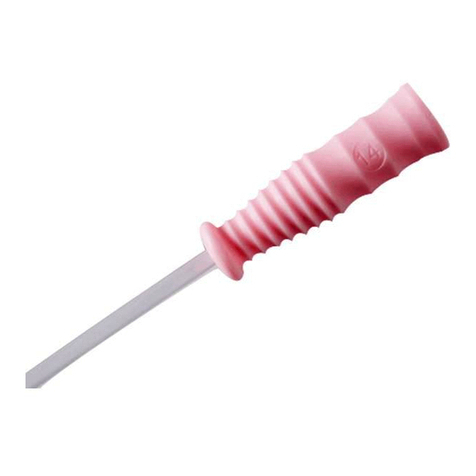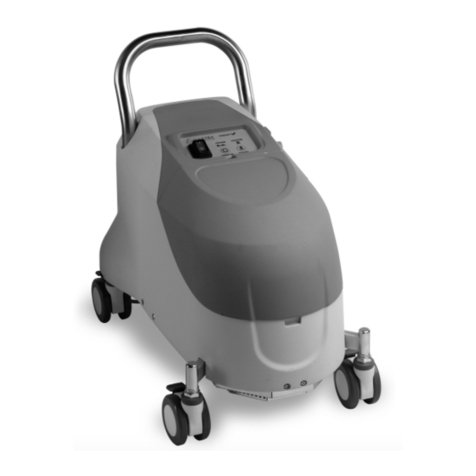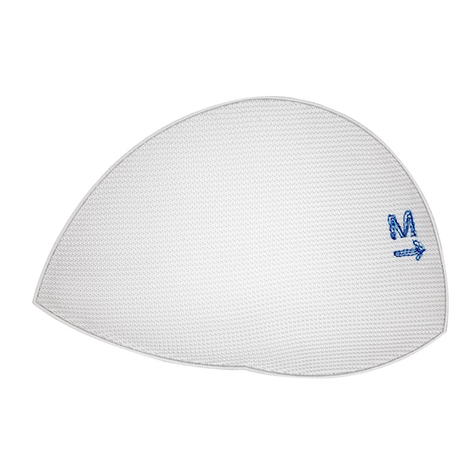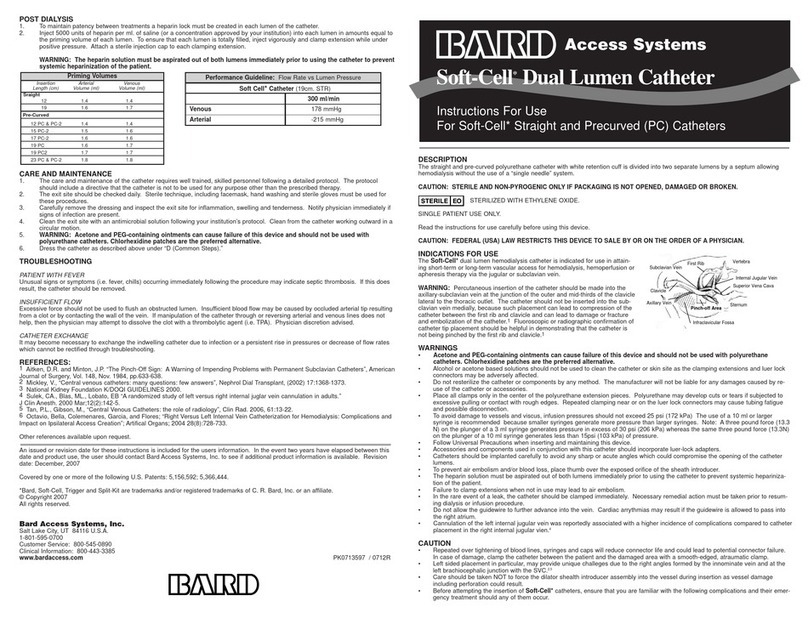
CARE AND MAINTENANCE
The care and maintenance of the catheter requires well trained, skilled personnel following a detailed protocol. The protocol should include a
directive that the catheter is not to be used for any purpose other than the prescribed therapy.
ACCESSING CATHETER, CAP CHANGES, DRESSING CHANGES3
• Experiencedpersonnel
• Useaseptictechnique
•Properhandhygiene
•Cleanglovestoaccesscatheterandremovedressingandsterileglovesfordressingchanges
•Surgicalmask(1forthepatientand1forthehealthcareprofessional)
• Catheterexitsiteshouldbeexaminedforsignsofinfectionanddressingsshouldbechangedateachdialysistreatment.
• CatheterLuer-lockConnectorswithendcapsattachedshouldbesoakedfor3to5minutesinpovidoneiodineandthenallowedtodry
before separation.
• Carefullyremovethedressingandinspecttheexitsiteforinammation,swellingandtenderness.Notifyphysicianimmediatelyifsignsof
infection are present.
EXIT SITE CLEANING9
• Useaseptictechnique(asoutlinedabove)
• Cleantheexitsiteateachdialysistreatmentwithchlorhexidinegluconateunlesscontraindicated.Applyantisepticpermanufacturer’s
recommendations.Allowtoairdrycompletely.
• Covertheexitsitewithsterile,transparent,semipermeabledressingorperhospitalprotocol.
RECOMMENDED CLEANING SOLUTIONS
Catheter Luer-lock Connectors/End Caps:
•Povidoneiodine(allowconnectors/endcapstosoakfor3to5
minutes)3
WARNING:Alcoholshouldnotbeusedtolock,soakordeclotpolyure-
thaneDialysisCathetersbecausealcoholisknowntodegradepoly-
urethanecathetersovertimewithrepeatedandprolongedexposure.
Hand cleaner solutions are not intended to be used for disinfecting
ourdialysiscatheterLuer-lockConnectors.
Exit Site:
•Chlorhexidinegluconate2%solution(preferred)3,7,8,9,10
•Chlorhexidinegluconate4%solution
•Diluteaqueoussodiumhypochlorite
•0.55%sodiumhypochloritesolution
•Povidoneiodine
•Hydrogenperoxide
•Chlorhexidinepatches
•Bacitracinzincointmentsinpetrolatumbases
WARNING:AcetoneandPEG-containingointmentscancausefailure
of this device and should not be used with polyurethane catheters.
Chlorhexidinepatchesorbacitracinzincointments(e.g.Polysporin*
ointment)arethepreferredalternative.
POST DIALYSIS
Useaseptictechnique(asoutlinedabove).
1. Flusharterialandvenouslumenswithaminimumof10mLofsterilesaline.
WARNING: Toavoiddamagetovesselsandviscus,infusionpressuresmustnotexceed25psi(172kPa).Theuseofa10mLorlargersyringeis
recommended because smaller syringes generate more pressure than larger syringes.
2. Injectheparinsolutionintoboththearterialandvenouslumensofthecatheter.Theappropriateheparinsolutionconcentrationandushing
frequencyshouldbebasedonhospitalprotocol.Heparinsolutionof1,000to5,000units/mLhasbeenfoundtobeeectiveformaintaining
thepatencyofhemodialysisandapheresiscatheters.Wheninjectingheparinsolution,injectquicklyandclampextensionwhileunderposi-
tivepressure.Heparinsolutionvolumetolockeachlumenmustbeequaltotheprimingvolumeofeachlumen.Primingvolumesaremarked
on each lumen.
3. CleancatheterLuer-lockconnectorsperhospitalprotocol.Attachsterileendcapstoboththearterialandthevenousclampingextension
pieces.
WARNING: Topreventsystemicheparinizationofthepatient,theheparinsolutionmustbeaspiratedoutofbothlumensimmediatelyprior
tousingthecatheter.Inmostinstances,nofurtherheparinsolutioninjectionisnecessaryfor48-72hours,providedthecatheterhasnot
beenaspiratedorushed.
CATHETER REMOVAL
Evaluatethecatheterroutinelyandpromptlyremoveanynonessentialcatheter9perphysician’sorders.Afterremovingthecatheter,apply
manualpressuretothepuncturesitefor10-15minutesuntilnosignsofbleedingarepresent.Thenapplysterile,transparent,semipermeable
dressingordressingperhospitalprotocolforaminimumof8hours.Followhospitalprotocolregardingbedrestaftercatheterremoval.
DISPOSAL
Afteruse,thecathetersandaccessoriesmaybeapotentialbiohazard.Handleanddisposeofinaccordancewithacceptedmedical
practice and all applicable laws and regulations.
TROUBLESHOOTING
PATIENT WITH FEVER
Patientwithfeverandchillsfollowingtheproceduremaybeindicativeofcatheter-relatedsepsis.Ifthisresults,removalofthecathetermaybe
indicated.
INSUFFICIENT FLOW
Excessiveforcemustnotbeusedtoushanobstructedlumen.Insufficientbloodowmaybecausedbyanoccludedtipresultingfromaclot
orbycontactingthewallofthevein.Ifmanipulationofthecatheterorreversingarterialandvenouslinesdoesnothelp,thenthephysicianmay
attempttodissolvetheclotwithathrombolyticagent(e.g.TPA,Catho*Activase*thrombolytic).Physiciandiscretionadvised.
CATHETER EXCHANGE
Donotroutinelyreplacedialysiscatheterstopreventcatheter-relatedinfections9.Itmaybecomenecessarytoexchangetheindwellingcatheter
duetoapersistentriseinpressuresordecreaseofowrateswhichcannotberectiedthroughtroubleshooting.Catheterexchangesshould
be performed under strict aseptic conditions in which the physician should wear a cap, mask, sterile gown, sterile gloves, and use a large sterile
drape to cover the patient.
REFERENCES
1. Aitken,D.R.andMinton,J.P.“ThePinch-OSign:AWarningofImpendingProblemswithPermanentSubclavianCatheters”,AmericanJournal
ofSurgery,Vol.148,Nov.1984,pp.633-638.
2. Mickley,V.,“Centralvenouscatheters:manyquestions:fewanswers”,NephrolDialTransplant,(2002)17:1368-1373.
3. NationalKidneyFoundationK/DOQIGUIDELINES2006.
4. Sulek,CA.,Blas,ML.,Lobato,EB,“Arandomizedstudyofleftversusrightinternaljugularveincannulationinadults.”JClinAnesth.2000
Mar;12(2):142-5
5. Tan,P.L.,Gibson,M.,“CentralVenousCatheters:theroleofradiology”,ClinRad.2006,61:13-22
6. Octavio,Bella,Colemenares,Garcia,andFlores;“RightVersesLeftInternalVeinCatheterizationforHemodialysis:ComplicationsandImpact
onIpsilateralAccessCreation”;ArticalOrgans;2004,28(8):728-733.
7. TheInstituteforHealthcareImprovement,“How-to-Guide:PreventCentralLineInfections,”2006.
8. TheJointCommissionHospitalAccreditationOrganization,NationalPatientSafetyGoals,2009.
9. CenterforDiseaseControlandPrevention,“GuidelinesforthePreventionofIntravascularCatheter-RelatedInfections,”MorbidityandMortal-
ityWeeklyReport,Aug.9,2002,51(RR-10),1-32.
10.TheSocietyforHealthcareEpidemiologyofAmerica,“StrategiestoPreventCentralLine-AssociatedBloodstreamInfectionsinAcuteCare
Hospitals,”InfectionControlandHospitalEpidemiology,Oct.2008,29(S1):S22-S30.
Otherreferencesavailableuponrequest
MRConditional
Non-clinicaltestinghasdemonstratedthedeviceisMRConditional.Itcanbescannedsafelyunder:
• staticmagneticeldof3Teslaorless
• spatialgradienteldof360Gauss/cmorless
• maximumspecicabsorptionrate(SAR)or4W/kgfor15minutesofscanning.
• Innon-clinicaltesting,thedeviceproducedatemperatureriseoflessthan1.4°Catamaximumspecicabsorptionrate
(SAR)of4W/kgfor15minutesofMRscanningina3TeslaSiemensTriowithsoftwareversionB15.
ForMinimalImageArtifact
• MRimagequalitymaybecompromisediftheareaofinterestisinthesameareaorrelativelyclosetothepositionoftheextensionlegs.
Therefore,itmaybenecessarytooptimizeMRimagingparametersforpresenceofthemetallicportionoftheextensionlegsormoveexten-
sion legs away from area of interest.
Anissuedorrevisiondatefortheseinstructionsisincludedfortheusersinformation.Intheeventtwoyearshaveelapsedbetweenthisdateand
product use, the user should contact Bard Access Systems, Inc. to see if additional product information is available.
Revisiondate:March2010.
*Bard, Duet and StatLockaretrademarksand/orregisteredtrademarksofC.R.Bard,Inc.
Allothertrademarksarethepropertyoftheirrespectiveowners.
©2010C. R. Bard, Inc. Allrightsreserved.
Bard Access Systems, Inc.
605North5600West
SaltLakeCity,UT84116U.S.A.
1-801-522-5000
CustomerService:800-545-0890
ClinicalInformation:800-443-3385
www.bardaccess.com
Long-TermHemodialysisCatheterSystem
DESCRIPTION
The Duet* Long-Term Hemodialysis Catheter System is made of Carbothane* radiopaque polyurethane. The catheter system is comprised of
twosingle10Frenchlumensthatallowforowratesashighas400mL/min.Eachcathetercomeswithanextensionlegandaretentioncufor
tissueingrowthtoanchorthecatheter.Thearterial(red)andvenous(blue)lumensaredistinguishedbythecolorcodingoftheprintingonthe
catheterandthecolor-codedLuer-lockconnector.
STERILIZATIONBYETHYLENEOXIDE.
Sterile,
Non-Pyrogenic
Unless Package is
Damaged or Opened.
Do not use if package is damaged
MRConditional Non-pyrogenic
This product does
notcontainDEHP This product and packaging do not
containnaturalrubberlatex.
INDICATIONS FOR USE
The Duet*Long-termHemodialysisCatheterSystemisindicatedforuseinattainingshort-termorlong-termvascularaccessforhemodialysis,
hemoperfusion,orapheresistherapy.Thecathetersmaybeinsertedpercutaneouslyintotheinternaljugularvein,subclavian,orexternaljugular
vein.
CONTRAINDICATION
Thisdeviceiscontraindicatedforpatientsexhibitingsevere,uncontrolledthrombocytopeniaorcoagulopathy.
WARNINGS
First Rib
Subclavian Vein
Clavicle
Vertebra
Internal Jugular Vei
Superior Vena Cava
Sternum
Pinch-off Area
Infraclavicular Fossa
Axillary Vein
WARNING:Ifthesubclavianveinisused,percutaneousinsertionofthecatheter
shouldbemadeintotheaxillary-subclavianveinatthejunctionoftheouterand
mid-thirdsoftheclaviclelateraltothethoracicoutlet.Thecathetershouldnotbe
insertedintothesubclavianveinmediallybecausesuchplacementcanleadtocom-
pressionofthecatheterbetweentherstribandclavicleandcanleadtodamageor
fractureandembolizationofthecatheter.1Fluoroscopicorradiographicconrmation
of catheter tip placement should be helpful in demonstrating that the catheter is not
beingpinchedbytherstribandclavicle.1
•Useofthesubclavianveinforcatheterplacementmayresultin
subclavianveinstenosis.Subclavianveinstenosismaypreventfuture
useoftheipsilateralextremityforpermanentaccess.Useofthejugular
vein is preferred.
•Alcoholoralcohol-containingantiseptics(suchaschlorhexidine)maybeusedto
cleanthecatheter/skinsite;however,careshouldbetakentoavoidprolongedorexcessivecontactwiththesolutions(s).
• AcetoneandPEG-containingointmentscancausefailureofthisdeviceandshouldnotbeusedwithpolyurethanecatheters.Chlorhexidine
patchesorbacitracinzincointments(e.g.,Polysporin* ointment)arethepreferredalternative.
• FollowUniversalPrecautionswheninsertingandmaintainingthisdevice.
• Cardiacarrhythmiasmayresultiftheguidewireisallowedtopassintotherightatrium.
• Donottunnelthroughmuscle.
• Clampingthecatheterrepeatedlyinthesamespotcouldweakenthetubing.Changethepositionoftheextensionclampsregularlyto
prolongthelifeoftheextensiontubing.AvoidclampingnearorontheLuer-lockconnectors,asthismaycausetubingfatigueandpossible
disconnection.Extensiontubingmaydeveloptearsorcutsifsubjectedtoexcessivepullingorcontactwithroughedges.Examinetubingfor
damage both prior to and after each treatment.
• Cathetersshouldbeimplantedcarefullytoavoidanysharporacuteangleswhichcouldcompromisetheopeningofthecatheterlumens.
• Topreventairembolismand/orbloodloss,placethumbovertheexposedoriceofthesheathintroducer.
• Toavoiddamagetovesselsandviscus,infusionpressuresshouldnotexceed25psi(172kPa).Theuseofa10mLorlargersyringeisrecom-
mended because smaller syringes generate more pressure than larger syringes. Note:Athreepound(13.3Newton)forceontheplungerof
a3mLsyringegeneratespressureinexcessof30psi(206kPa)whereasthesamethreepound(13.3Newton)forceontheplungerofa10mL
syringegenerateslessthan15psi(103kPa)ofpressure.
• AccessoriesandcomponentsusedinconjunctionwiththiscathetershouldincorporateLuer-lockconnectors.
• Theheparinsolutionmustbeaspiratedoutofbothlumensimmediatelypriortousingthecathetertopreventsystemicheparinizationofthe
patient.
• Failuretoclampextensionswhennotinusemayleadtoairembolism,bleeding,andpossibleocclusions.
• Intherareeventofaleak,thecathetershouldbeclampedimmediately.Necessaryremedialactionmustbetakenpriortoresumingdialysis,
hemoperfusion, or apheresis procedure.
• Donotresterilizethecatheterorcomponentsbyanymethod.Themanufacturerwillnotbeliableforanydamagescausedbyreuseofthe
catheter or accessories.
• Cannulationoftheleftinternaljugularveinisreportedlyassociatedwithahigherincidenceofcomplicationscomparedtocatheterplace-
mentintherightinternaljugularvein.4
• Donotadvanceguidewireorcatheterifunusualresistanceisencountered.
• TheblueCompressionSleeveisanecessarycomponentoftheExtensionLegAssembly.AlwaysvisuallyconrmthattheCompressionSleeve
remainsintheFemaleConnectorduringassembly.
• Alcoholshouldnotbeusedtolock,soakordeclotpolyurethaneDialysisCathetersbecausealcoholisknowntodegradepolyurethane
cathetersovertimewithrepeatedandprolongedexposure.
• Reusemaycreateariskofpatientinfectionofuserinfection,compromisethestructuralintegrityofthedevice,leadtodevicefailureand/or
leadtoinjury,illnessordeathofthepatient.
• TheSlideClamp,ThumbClamp,andPlugareprovidedforuseduringcatheterplacementonly.Donotreuse.
• Notintendedforpediatricorneonataluse.
• IntendedforSingleUse.DONOTREUSE.Reuseand/orrepackagingmaycreateariskofpatientoruserinfection,compromisethestructural
integrityand/oressentialmaterialanddesigncharacteristicsofthedevice,whichmayleadtodevicefailure,and/orleadtoinjury,illnessor
death of the patient.
CAUTIONS
• Repeatedovertighteningofbloodlines,syringesandcapswillreduceLuer-lockconnectorlifeandcouldleadtopotentialconnectorfailure.
Incaseofdamage,clampthecatheterbetweenthepatientandthedamagedareawithasmooth-edged,atraumaticclamp.
• Sterileandnon-pyrogeniconlyifpackagingisnotopened,damagedorbroken.
• Readtheinstructionsforusecarefullybeforeusingthisdevice.
• Federal(USA)lawrestrictsthisdevicetosalebyorontheorderofaphysician.
• CareshouldbetakenNOTtoforcethedilatorsheathintroducerintothevesselduringinsertionasvesseldamageincludingperforationcould
result.
• Leftsidedcatheterplacementmayprovideuniquechallengesduetotherightanglesformedbytheinnominateveinandattheleftbrachio-
cephalicjunctionwiththeSVC.2,5
• Ensurethatthesheathintroducerisonlytornexternally.Cathetermayneedtobefurtherpushedintothevesselassheathintroduceristorn.
• Foroptimalproductperformance,donotinsertanyportionofthecuintothevein.
• Careshouldbetakennottoadvancethesplitsheathtoofarintovesselasapotentialkinkwouldcreateanimpassetothecatheter.
• PlacementandcareoftheDuet*Cathetersshouldbeperformedbypersonsknowledgeableoftherisksinvolvedandqualiedintheproce-
dures.
• Donotcreateasharpbendincathetertunnelasthismaycausekinkingandimpactow.
• Iftheguidewiremustbewithdrawnwhiletheneedleisinserted,removeboththeneedleandguidewireasaunittopreventtheneedlefrom
damaging or shearing the guidewire.
• Cuttingthecatheteranywherebutthepre-printedmarkswillresultintheinabilitytoreadthecatheterlengthandprimingvolumes.
• Cathetertipsmustbestaggeredby4cmtominimizerecirculation.
• BeforeattemptingtheinsertionofDuet*Catheters,ensurethatyouarefamiliarwiththefollowingcomplicationsandtheiremergencytreat-
ment should any of them occur.
POSSIBLE COMPLICATIONS
These and other complications are well documented in medical literature and should be carefully considered before placing the catheter.
Theuseofanindwellingcentralvenouscatheterprovidesanimportantmeansofvenousaccessforcriticallyillpatients;however,thepotential
existsforseriouscomplicationsincludingthefollowing:
• AirEmbolism
• Bleeding
• BrachialPlexusInjury
• CardiacArrhythmia
• CatheterorCuErosionthroughtheSkin
• CatheterEmbolism
• CatheterOcclusion
• CatheterOcclusion,DamageorBreakage
duetoCompressionbetweentheClavicle
andFirstRiborKinking
• Catheter-relatedSepsis
• CardiacTamponade
• Endocarditis
• ExitSiteInfection
• ExitSiteNecrosis
• Extravasation
• FibrinSheathFormation
• Hemothorax
• Hemotoma
• Hydrothorax
• Inammation,Necrosisorscarringofskin
over implant area
• IntoleranceReactiontoImplantedDevice
• LacerationofVesselsorViscus
• Mediastinalwidening
• PerforationofVesselsorViscus
• Pneumothorax
• RetroperitonealBleed
• RisksNormallyAssociatedwithLocaland
GeneralAnesthesia,Surgery,andPost-
OperativeRecovery
• ThoracicDuctInjury
• Thromboembolism
• VenousThrombosis
• VentricularThrombosis
• VesselErosion
0724304/1003R
